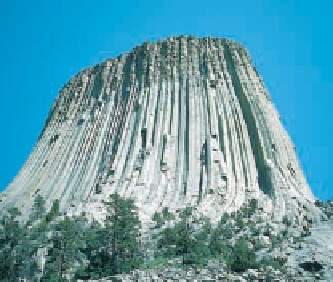Geology Reference
In-Depth Information
An absolute age determined
for one of the dikes indicates that
Shiprock is about 27 million years
old. When the original volcano
formed, apparently during explosive
eruptions, rising magma penetrated
various rocks, including the Mancos
Shale, the rock unit now exposed at
the surface adjacent to Shiprock. The
rock that makes up Shiprock itself is
tuff breccia, consisting of fragmented
volcanic debris, as well as pieces of
metamorphic, sedimentary, and
igneous rocks.
Geologists agree that Devil's Tower
in northeastern Wyoming cooled from
a small body of magma and that
erosion has exposed it in its present
form (
translation taken from this phrase.
The tower's most conspicuous
features are the near-vertical lines
that, according to Cheyenne legends,
are scratch marks made by a gigan-
tic grizzly bear. One legend holds
that the bear made the scratches
while pursuing a group of children.
Another tells of six brothers and a
woman also pursued by a grizzly
bear. One brother carried a rock, and
when he sang a song, it grew into
Devil's Tower, safely carrying the
brothers and woman out of the bear's
reach.
Although not nearly as interesting
as the Cheyenne legends, the origin
of the “scratch marks” is well under-
stood. These lines actually formed at
the intersections of
columnar joints
,
fractures that form in response to the
cooling and contraction that occur in
some plutons and lava fl ows
(see Chapter 5). The columns
outlined by these fractures are up to
2.5 m across, and the pile of rubble
at the tower's base is simply an
accumulation of collapsed
columns.
◗
Figure 3
Devil's Tower in northeastern
Wyoming rises approximately 260 m above
its base. It may be a volcanic neck or an
eroded laccolith. The vertical lines result
from intersections of fractures called
columnar joints. According to Cheyenne
legend, a gigantic grizzly bear made the
deep scratches.
Figure 3). However, opinion
is divided on whether it is a volcanic
neck or an eroded laccolith. In either
case, the rock that makes up Devil's
Tower is 45 to 50 million years old,
and President Theodore Roosevelt
designated this impressive landform
as our fi rst national monument in
1906. At 260 m high, Devil's Tower
is visible from 48 km away and served
as a landmark for early travelers in
◗
this area. It achieved further distinc-
tion in 1977 when it was featured in
the fi lm
Close Encounters of the Third
Kind.
The Cheyenne and Sioux na-
tions call Devil's Tower
Mateo Tepee
,
meaning “Grizzly Bear Lodge.” It was
also called the “Bad God's Tower,”
and reportedly “Devil's Tower” is a
composition can change so that the same magma may
yield more than one kind of igneous rock.
According to Bowen's reaction series, cooling mafi c magma
yields a sequence of minerals, each of which is stable
within specifi c temperature ranges. Only ferromagnesian
silicates are found in the discontinuous branch of Bowen's
reaction series. The continuous branch of the reaction
series yields only plagioclase feldspars that become increas-
ingly enriched with sodium as cooling occurs.
A chemical change in magma may take place as early
ferromagnesian silicates form and, because of their
density, settle in the magma.
Compositional changes also take place in magma when it
assimilates country rock or one magma mixes with another.
Geologists recognize two broad categories of igneous
rocks: volcanic or extrusive and plutonic or intrusive.
Texture and composition are the criteria used to
classify igneous rocks, although a few are defi ned
only by texture.
Crystallization from water-rich magma results in
very large minerals that form rocks known as pegma-
tite. Most pegmatite has an overall composition simi-
lar to granite.
Intrusive igneous bodies known as plutons vary in
their geometry and their relationship to country
rock: Some are concordant, whereas others are
discordant.
The largest plutons, known as batholiths, consist of
multiple intrusions of magma during long periods of
time.
Most plutons, including batholiths, are found at or
near divergent and convergent plate boundaries.
■
■
■
■
■
■
■
■
■


Search WWH ::

Custom Search